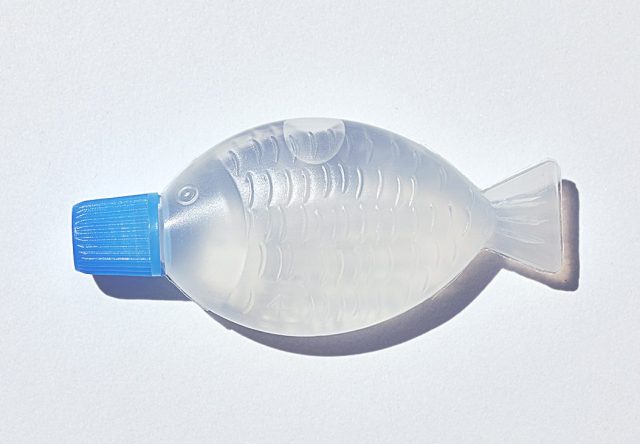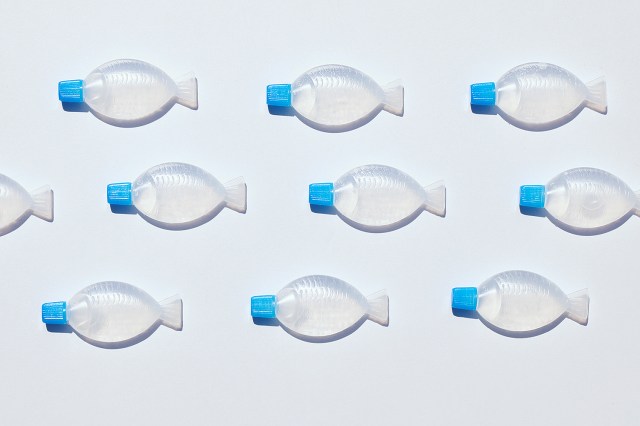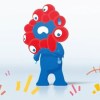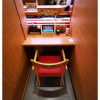
What could possibly go wrong?
Spend any time in Japan and you’ll probably come across those tiny fish-shaped bottles of single-serving soy sauce. From in-flight meals to school lunches they help give meals just that right amount of salty zing.
However, in-flight meals and school lunches are virtually non-existent in today’s world. As a result, tiny fish-shaped bottle suppliers are left with a massive surplus.
Cut over to the producers of Cleanse EX, an all-natural disinfectant made from grapefruit seed extract that is purportedly highly effective against viruses, bacteria, and molds. Although, having a plentiful supply of Cleanse EX, they found themselves with a shortage of containers.
The rest is history, as outlined in this adorable promotional video for SafeHandFish.
The name is somewhat misleading in that SafeHandFish is actually meant to clean surfaces such as tables and door handles, rather than hands or tableware. The “Hand” is likely more to due with the portability of these containers (the video’s Japanese title includes the word keitai suru, meaning “to keep at hand/carry with you,” and keitai denwa, mobile phones, have sometimes been referred to as “handy phones” in Japan).
SafeHandFish is said to be “completely natural” and “considered as a food additive under the Food Sanitation Law” according to the product’s website. However, immediately after that it also says “this product is not intended to be used on the human body” and “this product is not edible.”
These bottles are intended to be slipped into take-out and delivery meals much like a regular bottle of soy sauce would. That probably sounds inherently dangerous since it’s essentially a household disinfectant that looks nearly identical to a condiment and is served in an almost identical fashion as a condiment.
To address these concerns, these bottles are given a blue cap to distinguish SafeHandFish from the red-capped soy sauce bottles. Blue was also selected as a tribute to the UN, whose call for creatives to help fight COVID-19 inspired SafeHandFish’s creation.
That might not seem like much, but actually the red cap is so ingrained in Japanese culture, that it would probably be quite jarring to receive a blue-capped bottle. It’d be like getting a black toothpick in that it’s not especially shocking, but enough to make one say, “Hey, look at that.” They also appear to have little plastic wrappers, giving the user crucial extra time to notice what it really is.
This brings us to the next concern, however, as many people would also argue that the tiny fish-shaped bottle industry is not one worth saving due to the large amount of single-use plastics involved.
There’s still a chance this whole situation could work out well for everyone though. By providing a much needed product, SafeHandFish is probably making the best possible use of the existing stock of tiny fish-shaped bottles. Meanwhile, this disruption in the status quo caused by COVID-19 is potentially an ideal time for bottle makers to explore some highly desired alternative packaging ideas.
Granted it’s probably not the likeliest scenario, but if our current predicament has taught us one thing, it’s that anything is possible.
Source: SafeHandFish, TV Asahi
Images: PR Times
● Want to hear about SoraNews24’s latest articles as soon as they’re published? Follow us on Facebook and Twitter!



 Celebrate your love for Japanese bento with new soy sauce fish bottle pens
Celebrate your love for Japanese bento with new soy sauce fish bottle pens Internet reacts with confusion to Muji’s new fill-it-up-yourself water bottle product
Internet reacts with confusion to Muji’s new fill-it-up-yourself water bottle product Disney soy sauce is now on sale in Japan—four different tastes, four cute designs
Disney soy sauce is now on sale in Japan—four different tastes, four cute designs Transparent soy sauce is a thing — we saw it, we tried it, we’re confused by it
Transparent soy sauce is a thing — we saw it, we tried it, we’re confused by it PPAP’s Pikotaro launches new attack against coronavirus with medicated hand-soap line
PPAP’s Pikotaro launches new attack against coronavirus with medicated hand-soap line McDonald’s new Happy Meals offer up cute and practical Sanrio lifestyle goods
McDonald’s new Happy Meals offer up cute and practical Sanrio lifestyle goods All-you-can-drink Starbucks and amazing views part of Tokyo’s new 170 meter-high sky lounge
All-you-can-drink Starbucks and amazing views part of Tokyo’s new 170 meter-high sky lounge Studio Ghibli glasses cases let anime characters keep an eye on your spectacles
Studio Ghibli glasses cases let anime characters keep an eye on your spectacles Super Nintendo World expansion gets delayed for several months at Universal Studios Japan
Super Nintendo World expansion gets delayed for several months at Universal Studios Japan Kyoto’s 100 Demons yokai monster parade returns!
Kyoto’s 100 Demons yokai monster parade returns! Beautiful Sailor Moon manhole cover coasters being given out for free by Tokyo tourist center
Beautiful Sailor Moon manhole cover coasters being given out for free by Tokyo tourist center Osaka’s creepy cute mascot speaks for first time, adds more fuel the creepy OR cute debate【Video】
Osaka’s creepy cute mascot speaks for first time, adds more fuel the creepy OR cute debate【Video】 More foreign tourists than ever before in history visited Japan last month
More foreign tourists than ever before in history visited Japan last month A visit to the best UFO catcher arcade in the universe!
A visit to the best UFO catcher arcade in the universe! Japanese revolving sushi restaurant creates solo-diner capsules for a private world of sushi
Japanese revolving sushi restaurant creates solo-diner capsules for a private world of sushi Disney princesses get official manga makeovers for Manga Princess Cafe opening in Tokyo
Disney princesses get official manga makeovers for Manga Princess Cafe opening in Tokyo Starbucks reopens at Shibuya Scramble Crossing with new look and design concept
Starbucks reopens at Shibuya Scramble Crossing with new look and design concept Beautiful new Final Fantasy T-shirt collection on the way from Uniqlo【Photos】
Beautiful new Final Fantasy T-shirt collection on the way from Uniqlo【Photos】 Is the new Shinkansen Train Desk ticket worth it?
Is the new Shinkansen Train Desk ticket worth it? Foreign English teachers in Japan pick their favorite Japanese-language phrases【Survey】
Foreign English teachers in Japan pick their favorite Japanese-language phrases【Survey】 Japanese convenience store packs a whole bento into an onigiri rice ball
Japanese convenience store packs a whole bento into an onigiri rice ball We try out “Chan Ramen”, an underground type of ramen popular in the ramen community
We try out “Chan Ramen”, an underground type of ramen popular in the ramen community Studio Ghibli releases Kiki’s Delivery Service chocolate cake pouches in Japan
Studio Ghibli releases Kiki’s Delivery Service chocolate cake pouches in Japan Japan’s bone-breaking and record-breaking roller coaster is permanently shutting down
Japan’s bone-breaking and record-breaking roller coaster is permanently shutting down New definition of “Japanese whiskey” goes into effect to prevent fakes from fooling overseas buyers
New definition of “Japanese whiskey” goes into effect to prevent fakes from fooling overseas buyers Our Japanese reporter visits Costco in the U.S., finds super American and very Japanese things
Our Japanese reporter visits Costco in the U.S., finds super American and very Japanese things Studio Ghibli unveils Mother’s Day gift set that captures the love in My Neighbour Totoro
Studio Ghibli unveils Mother’s Day gift set that captures the love in My Neighbour Totoro Foreign passenger shoves conductor on one of the last full runs for Japan’s Thunderbird train
Foreign passenger shoves conductor on one of the last full runs for Japan’s Thunderbird train Domino’s Japan now sells…pizza ears?
Domino’s Japan now sells…pizza ears? New Japanese KitKat flavour stars Sanrio characters, including Hello Kitty
New Japanese KitKat flavour stars Sanrio characters, including Hello Kitty Kyoto creates new for-tourist buses to address overtourism with higher prices, faster rides
Kyoto creates new for-tourist buses to address overtourism with higher prices, faster rides Sales of Japan’s most convenient train ticket/shopping payment cards suspended indefinitely
Sales of Japan’s most convenient train ticket/shopping payment cards suspended indefinitely Sold-out Studio Ghibli desktop humidifiers are back so Totoro can help you through the dry season
Sold-out Studio Ghibli desktop humidifiers are back so Totoro can help you through the dry season Japanese government to make first change to romanization spelling rules since the 1950s
Japanese government to make first change to romanization spelling rules since the 1950s Ghibli founders Toshio Suzuki and Hayao Miyazaki contribute to Japanese whisky Totoro label design
Ghibli founders Toshio Suzuki and Hayao Miyazaki contribute to Japanese whisky Totoro label design Doraemon found buried at sea as scene from 1993 anime becomes real life【Photos】
Doraemon found buried at sea as scene from 1993 anime becomes real life【Photos】 Tokyo’s most famous Starbucks is closed
Tokyo’s most famous Starbucks is closed One Piece characters’ nationalities revealed, but fans have mixed opinions
One Piece characters’ nationalities revealed, but fans have mixed opinions We asked a Uniqlo employee what four things we should buy and their suggestions didn’t disappoint
We asked a Uniqlo employee what four things we should buy and their suggestions didn’t disappoint Princesses, fruits, and blacksmiths: Study reveals the 30 most unusual family names in Japan
Princesses, fruits, and blacksmiths: Study reveals the 30 most unusual family names in Japan Trying some Umui sauces made only on a remote Japanese island with a population of 50【Taste test】
Trying some Umui sauces made only on a remote Japanese island with a population of 50【Taste test】 Coca-Cola raises prices in Japan for the first time in 27 years
Coca-Cola raises prices in Japan for the first time in 27 years Hot spring in Gunma Prefecture found to reduce COVID-19 infectivity by over 90 percent
Hot spring in Gunma Prefecture found to reduce COVID-19 infectivity by over 90 percent Possibly the most useless product in the world: The Plastic Bottle Bottom Cap
Possibly the most useless product in the world: The Plastic Bottle Bottom Cap Mr Sato tries the gorgeous new bonsai parfait that everyone’s talking about in Harajuku
Mr Sato tries the gorgeous new bonsai parfait that everyone’s talking about in Harajuku Tottori airport serves crab soup from a faucet and… Dammit Seiji, put down that plastic bottle!
Tottori airport serves crab soup from a faucet and… Dammit Seiji, put down that plastic bottle! New “Bottle Man” bottle-cap battle toys too popular, sold out all over Japan on release day【Vid】
New “Bottle Man” bottle-cap battle toys too popular, sold out all over Japan on release day【Vid】 Poisonous blowfish ramen restaurant in Tokyo is death-defyingly delicious【Taste test】
Poisonous blowfish ramen restaurant in Tokyo is death-defyingly delicious【Taste test】 Here are seven genius items to give new life an purpose to old water bottles
Here are seven genius items to give new life an purpose to old water bottles Ramen-flavor cooking sauce now on sale from one of Japan’s favorite noodle chains
Ramen-flavor cooking sauce now on sale from one of Japan’s favorite noodle chains Kewpie Mayo Cafe celebrates Mayonnaise Day with a month of mayo-hem, special menu
Kewpie Mayo Cafe celebrates Mayonnaise Day with a month of mayo-hem, special menu New Japanese bath oils make you feel like you’re soaking in soy sauce and rayu chilli oil
New Japanese bath oils make you feel like you’re soaking in soy sauce and rayu chilli oil Dress up your plain old water bottle to look like a hero from the Kobe City Fire Department
Dress up your plain old water bottle to look like a hero from the Kobe City Fire Department No electricity? No problem! Empty plastic bottles are helping to cool homes in impoverished areas
No electricity? No problem! Empty plastic bottles are helping to cool homes in impoverished areas Starbucks Japan releases cat tumblers as part of new drinkware range for summer 2019
Starbucks Japan releases cat tumblers as part of new drinkware range for summer 2019 Furikake rice toppings gaining popularity in US, but are Americans doing it wrong?
Furikake rice toppings gaining popularity in US, but are Americans doing it wrong?
Leave a Reply